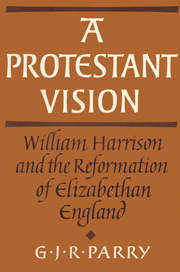2 - A reformed chronology – patterns and parallels
Published online by Cambridge University Press: 20 October 2009
Summary
Harrison's obsession with ‘the exact correction of the time’ in his historical studies reflects his belief that the apocalyptic conflict of the Two Churches provided the backbone for his ‘Chronology’. For the True Church suffered and prospered in accordance with God's predestinate will, expressed through his prophets in their calls to obedience. Time therefore played a dynamic role in fulfilling the prophecies concerning the True Church, and Harrison felt that in studying the mysterious patterns and symmetries of chronology he participated in a divine revelation whose enormous contemporary significance could be dimly apprehended, but which would only be fully explained at the end of history. For to his way of thinking the past fulfilment of divine prophecy confirmed its contemporary relevance; the present merely continued the irresistible working-out of the majestic divine plan.
Harrison's confidence in the historical and chronological evidence for the existence of this predestined continuum of events allowed him to gloss over internal discrepancies in Scriptural prophecy and chronology which later commentators came to find increasingly disturbing. In turn his unclouded trust in the authority of the Scriptures further encouraged his interest in the assumed prophetic patterns of chronology. What he imagined to be Scriptural criteria always directed his interests in such fields, enabling him to reject or adopt current historical patterns and prophecies by reference to the shared experiences and teachings of the Elect covenant line. Eventually this secure vantage point allowed him to extend the canon of legitimate prophecy to areas where other prophetic interpreters felt unable to follow.
- Type
- Chapter
- Information
- A Protestant VisionWilliam Harrison and the Reformation of Elizabethan England, pp. 58 - 95Publisher: Cambridge University PressPrint publication year: 1987

